Abstract
1. Azopigments derived from conjugated bile pigments by coupling with the diazonium salt of ethyl anthranilate are analysed conveniently by quantitative t.l.c. or by column chromatography on CM-cellulose. 2. By chromatographic studies combined with a series of chemical tests six groups of azopigments were demonstrable in preparations from bile and from icteric urine of man. Azobilirubin and its β-d-monoglucuronide have hitherto been considered to be the only major derivatives that can be obtained from human bile pigments. In the present work, other azopigments accounted for 30–40% of the total azopigment material, and the amounts of these showed considerable variation among biological fluids. 3. The divergence of the present results from earlier work is probably related to the use of milder diazotization conditions and of chromatographic techniques with a high resolving power. 4. The thin-layer chromatographic systems developed allow rapid and quantitative analysis of azopigments derived from bile pigments.
Full text
PDF

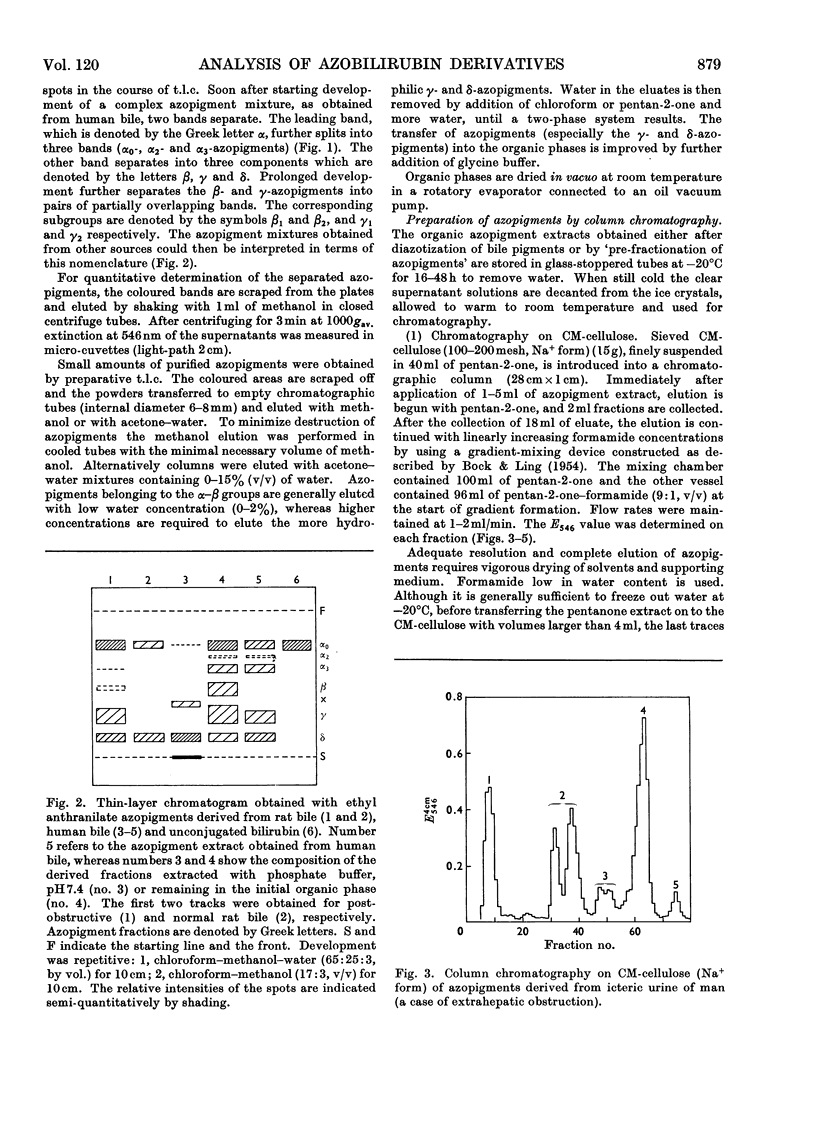
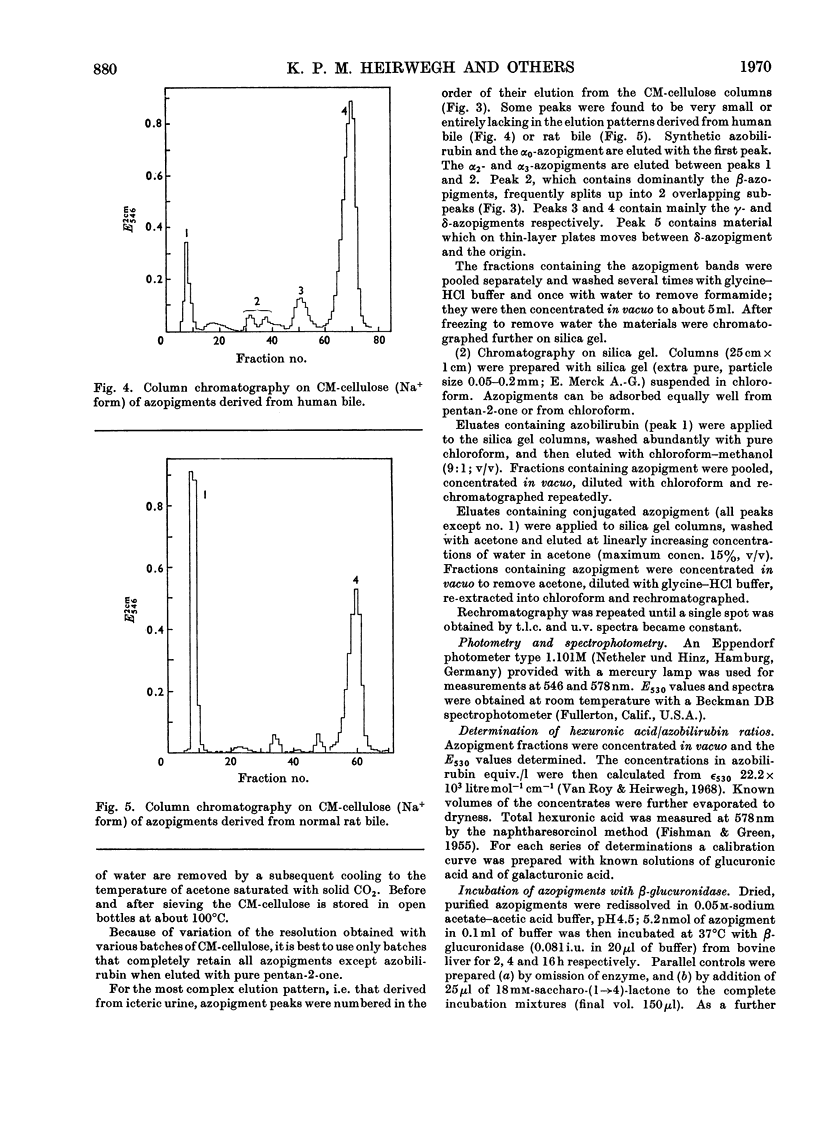


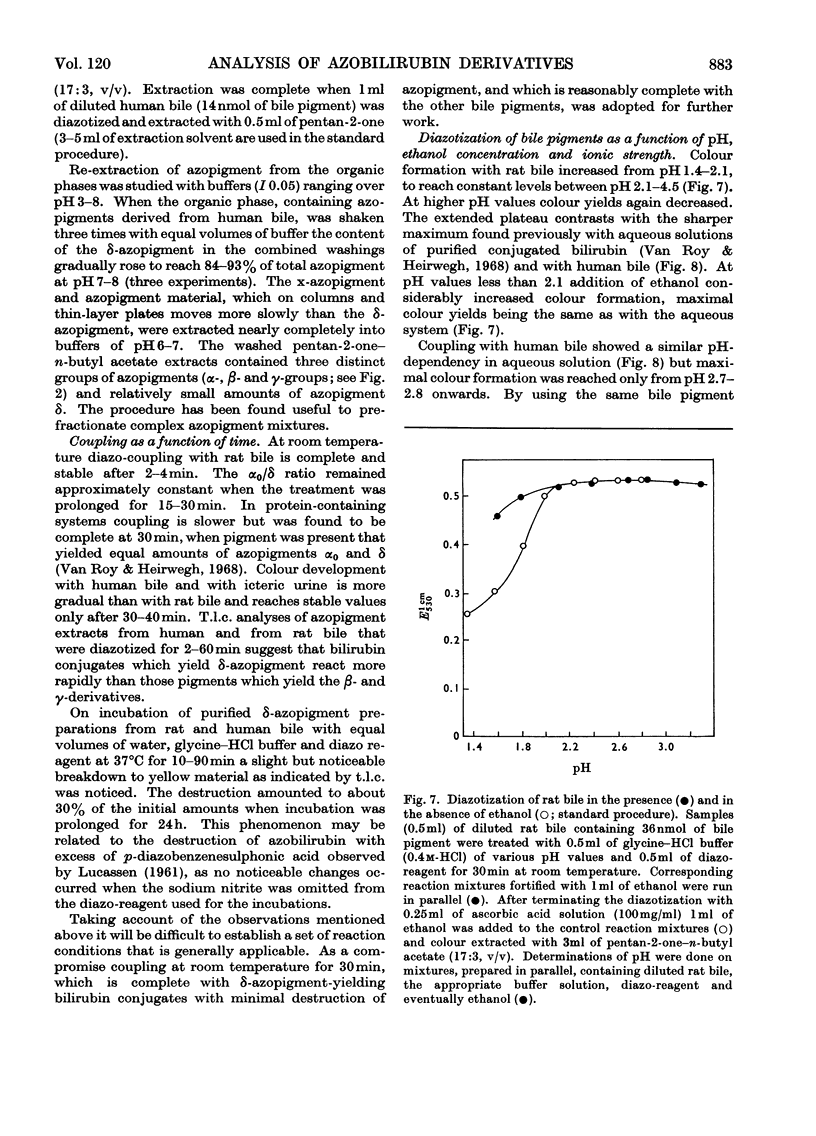
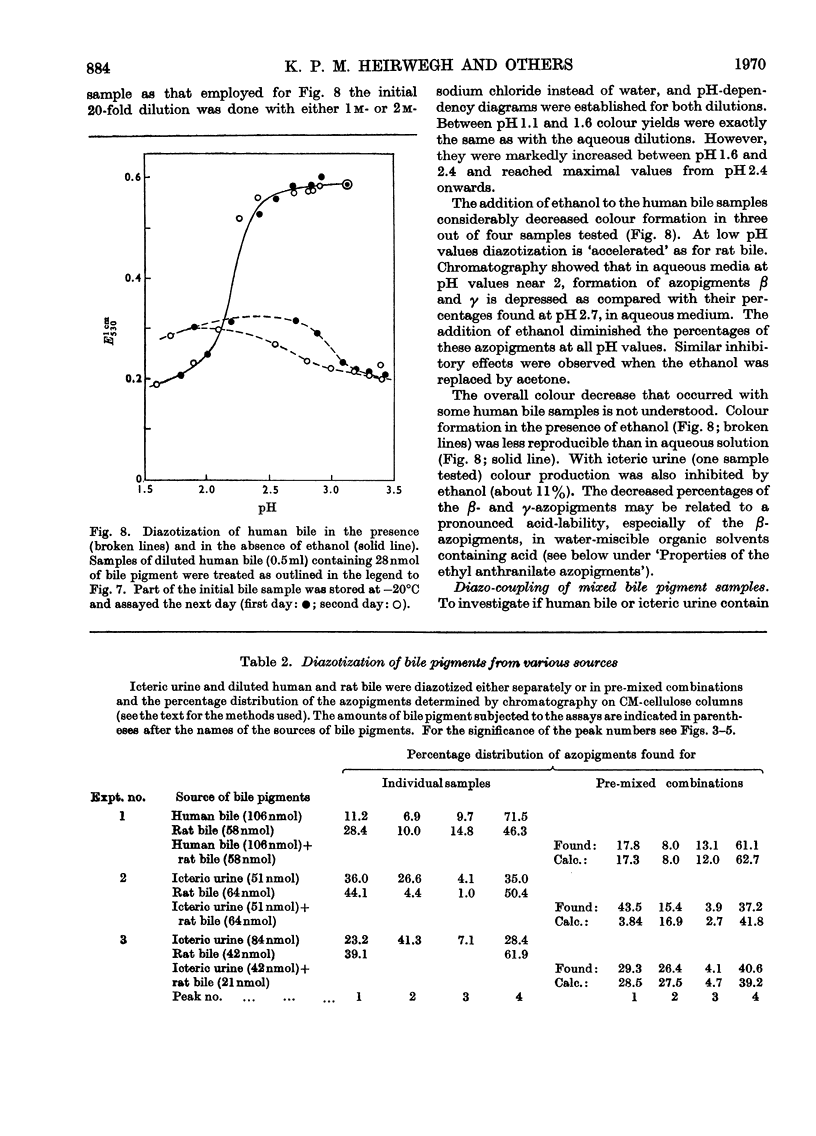

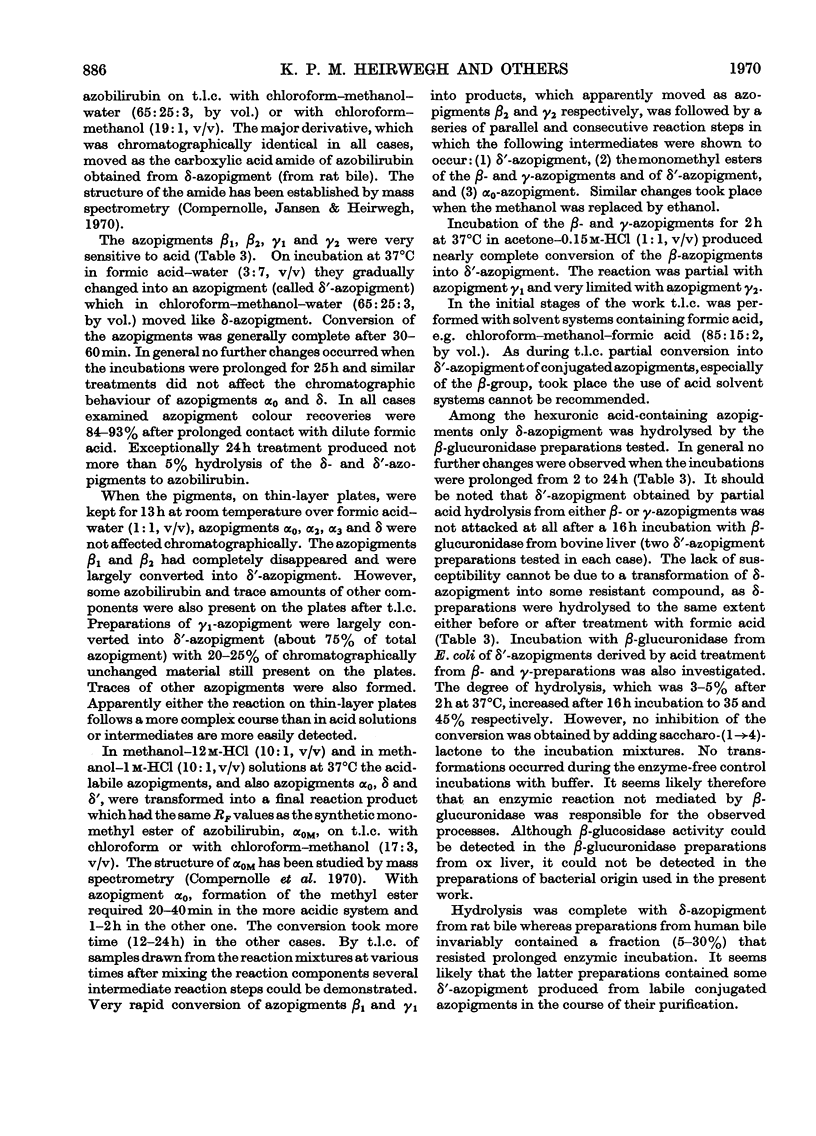


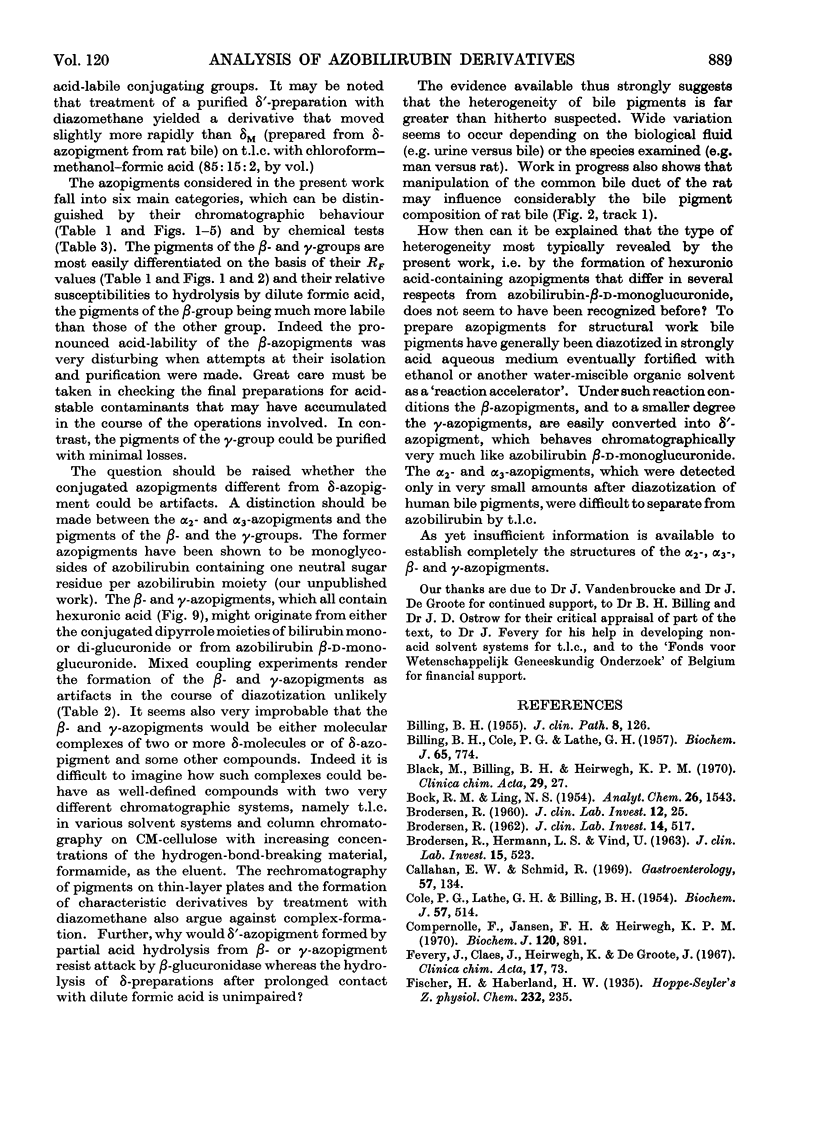

Selected References
These references are in PubMed. This may not be the complete list of references from this article.
- BILLING B. H. A chromatographic method for the determination of the three bile pigments in serum. J Clin Pathol. 1955 May;8(2):126–129. doi: 10.1136/jcp.8.2.126. [DOI] [PMC free article] [PubMed] [Google Scholar]
- BILLING B. H., COLE P. G., LATHE G. H. The excretion of bilirubin as a diglucuronide giving the direct van den Bergh reaction. Biochem J. 1957 Apr;65(4):774–784. doi: 10.1042/bj0650774. [DOI] [PMC free article] [PubMed] [Google Scholar]
- BRODERSEN R. Contribution to the identification of bile pigments in normal human serum. Scand J Clin Lab Invest. 1962;14:517–527. doi: 10.3109/00365516209051273. [DOI] [PubMed] [Google Scholar]
- BRODERSEN R., HERMANN L. S., VIND I. NORMAL BILIRUBIN CONCENTRATION AND THE OCCURRENCE OF OTHER BILE PIGMENTS IN HUMAN BLOOD SERA. Scand J Clin Lab Invest. 1963;15:523–528. [PubMed] [Google Scholar]
- Black M., Billing B. H., Heirwegh K. P. Determination of bilirubin UDP-glucuronyl transferase activity in needle-biopsy specimens of human liver. Clin Chim Acta. 1970 Jul;29(1):27–35. doi: 10.1016/0009-8981(70)90216-0. [DOI] [PubMed] [Google Scholar]
- COLE P. G., LATHE G. H., BILLING B. H. Separation of the bile pigments of serum, bile and urine. Biochem J. 1954 Jul;57(3):514–518. doi: 10.1042/bj0570514. [DOI] [PMC free article] [PubMed] [Google Scholar]
- Callahan E. W., Jr, Schmid R. Excretion of unconjugated bilirubin in the bile of Gunn rats. Gastroenterology. 1969 Aug;57(2):134–137. [PubMed] [Google Scholar]
- Compernolle F., Jansen F. H., Heirwegh K. P. Mass-spectrometric study of the azopigments obtained from bile pigments with diazotized ethyl anthranilate. Biochem J. 1970 Dec;120(4):891–894. doi: 10.1042/bj1200891. [DOI] [PMC free article] [PubMed] [Google Scholar]
- FISHMAN W. H., GREEN S. Microanalysis of glucuronide glucuronic acid as applied to beta-glucuronidase and glucuronic acid studies. J Biol Chem. 1955 Aug;215(2):527–537. [PubMed] [Google Scholar]
- FOG J. BILIRUBIN-PURIFICATION-PURITY. Scand J Clin Lab Invest. 1964;16:49–54. doi: 10.3109/00365516409060482. [DOI] [PubMed] [Google Scholar]
- Fevery J., Claes J., Heirwegh K., De Groote J. Hyperbilirubinemia: significance of the ratio between direct-reacting and total bilirubin. Clin Chim Acta. 1967 Jul;17(1):73–79. doi: 10.1016/0009-8981(67)90098-8. [DOI] [PubMed] [Google Scholar]
- GARAY E. R., NOIR B., ROYER M. BILIVERDIN PIGMENTS IN GREEN BILES. Biochim Biophys Acta. 1965 May 4;100:411–417. doi: 10.1016/0304-4165(65)90010-3. [DOI] [PubMed] [Google Scholar]
- GREGORY C. H. Studies of conjugated bilirubin. III. Pigment I, a complex of conjugated and free bilirubin. J Lab Clin Med. 1963 Jun;61:917–925. [PubMed] [Google Scholar]
- GREGORY C. H., WATSON C. J. Studies of conjugated bilirubin. II. Problem of sulfates of bilirubin in vivo and in vitro. J Lab Clin Med. 1962 Jul;60:17–30. [PubMed] [Google Scholar]
- Heirwegh K. P., Meuwissen J. A., Jansen F. H. On the quantitation and analysis of bile pigments in amniotic fluid. Biol Neonat. 1969;14(1):74–79. doi: 10.1159/000240172. [DOI] [PubMed] [Google Scholar]
- ISSELBACHER K. J., McCARTHY E. A. Identification of a sulfate conjugate of bilirubin in bile. Biochim Biophys Acta. 1958 Sep;29(3):658–659. doi: 10.1016/0006-3002(58)90034-9. [DOI] [PubMed] [Google Scholar]
- ISSELBACHER K. J., McCARTHY E. A. Studies on bilirubin sulfate and other nonglucuronide conjugates of bilirubin. J Clin Invest. 1959 Apr;38(4):645–651. doi: 10.1172/JCI103842. [DOI] [PMC free article] [PubMed] [Google Scholar]
- Jacobsen J. A chromatographic separation of bilirubin glucuronides from human bile. Acta Chem Scand. 1969;23(9):3023–3026. doi: 10.3891/acta.chem.scand.23-3023. [DOI] [PubMed] [Google Scholar]
- Lester R., Troxler R. F. Recent advances in bile pigment metabolism. Gastroenterology. 1969 Jan;56(1):143–169. [PubMed] [Google Scholar]
- NOIR B. A., GARAY E. R., ROYER M. SEPARATION AND PROPERTIES OF CONJUGATED BILIVERDIN. Biochim Biophys Acta. 1965 May 4;100:403–410. doi: 10.1016/0304-4165(65)90009-7. [DOI] [PubMed] [Google Scholar]
- Noir B. A., Groszman R. J., De Walz A. T. Studies on bilirubin sulphate. Biochim Biophys Acta. 1966 Apr 25;117(2):297–304. doi: 10.1016/0304-4165(66)90080-8. [DOI] [PubMed] [Google Scholar]
- Ostrow J. D., Murphy N. H. Isolation and properties of conjugated bilirubin from bile. Biochem J. 1970 Nov;120(2):311–327. doi: 10.1042/bj1200311. [DOI] [PMC free article] [PubMed] [Google Scholar]
- PITTERA A., CASSIA B. SEPARAZIONE CROMATOGRAFICA SU CARTA DEGLI AZOPIGMENTI DELLA BILIRUBINA SIERICA. Fegato. 1963 Dec;18:457–470. [PubMed] [Google Scholar]
- SCHMID R. The identification of direct-reacting bilirubin as bilirubin glucuronide. J Biol Chem. 1957 Dec;229(2):881–888. [PubMed] [Google Scholar]
- SCHOENFIELD L. J., BOLLMAN J. L. Further studies on the nature and source of the conjugated bile pigments. Proc Soc Exp Biol Med. 1963 Apr;112:929–932. doi: 10.3181/00379727-112-28213. [DOI] [PubMed] [Google Scholar]
- SCHOENFIELD L. J., BOLLMAN J. L., HOFFMAN H. N., 2nd Sulfate and glucuronide conjugates of bilirubin in experimental liver injury. J Clin Invest. 1962 Jan;41:133–140. doi: 10.1172/JCI104455. [DOI] [PMC free article] [PubMed] [Google Scholar]
- VEGAS F. R. Chromatographic behavior on ion-exchange paper of bilirubin conjugated with sulfate and glucuronide. Anal Biochem. 1963 Jun;5:465–470. doi: 10.1016/0003-2697(63)90065-4. [DOI] [PubMed] [Google Scholar]
- Van Roy F. P., Heirwegh K. P. Determination of bilirubin glucuronide and assay of glucuronyltransferase with bilirubin as acceptor. Biochem J. 1968 Apr;107(4):507–518. doi: 10.1042/bj1070507. [DOI] [PMC free article] [PubMed] [Google Scholar]
- WATSON C. J. Color reaction of bilirubin with sulfuric acid: a direct diazo-reacting bilirubin sulfate. Science. 1958 Jul 18;128(3316):142–143. doi: 10.1126/science.128.3316.142. [DOI] [PubMed] [Google Scholar]


